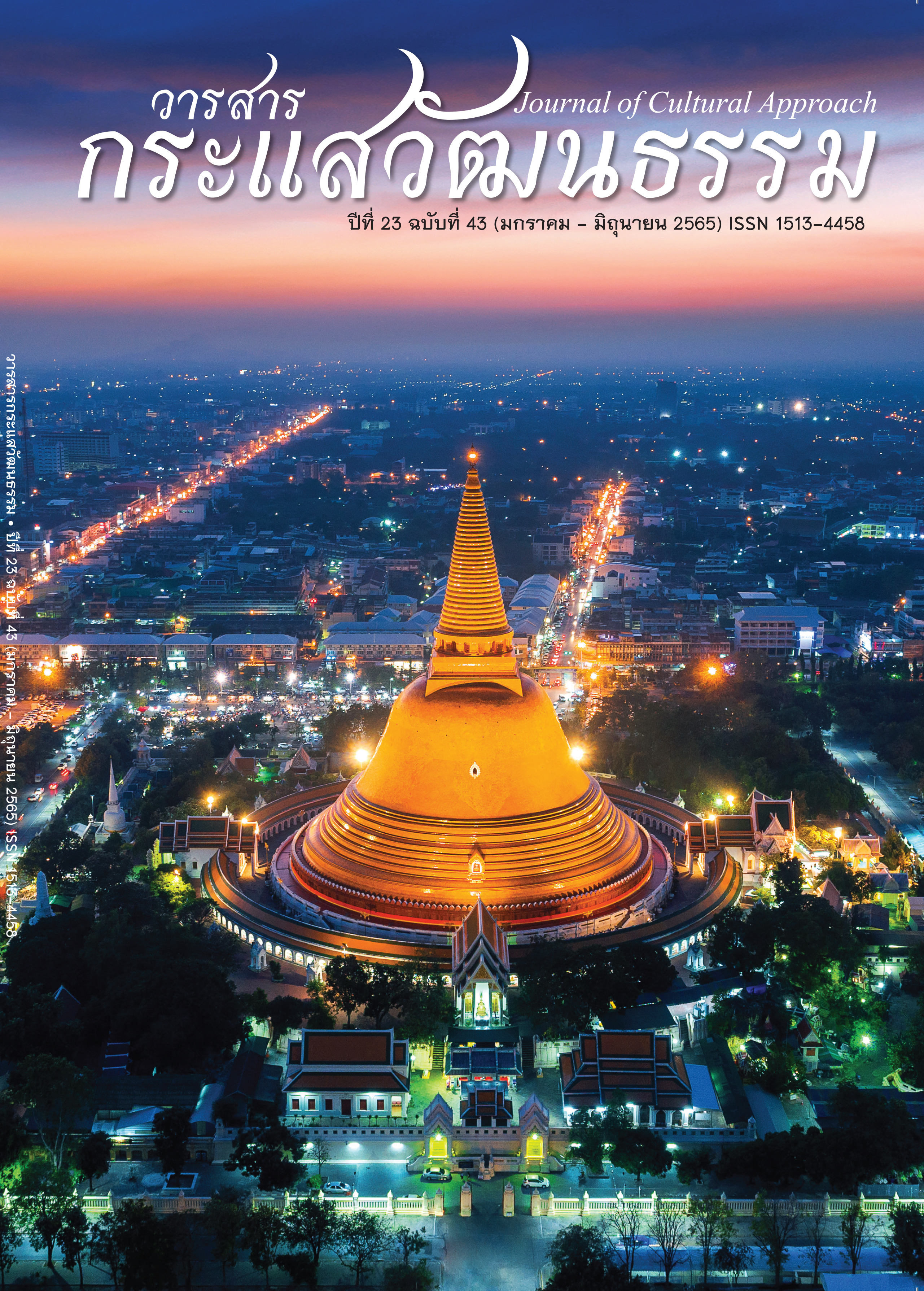Good Luck Animal Amulets in Thai Magazines : Contemporary Thai Social Values
Main Article Content
Abstract
This research aims to analyze social values by exploring and classifying animal amulets in contemporary Thai Magazines by focusing on amulet qualities and the language used. The gathered information was from Thai publications between March and June of 2021. The study is qualitative in nature. The results shows that there are 18 animal amulets, most of them contain folk Buddhism. The animal amulets are distinguished by the animal’s skills as well as its names and qualifications. This corresponds to the preferences of the Thai individual. In Thailand, people value fortune and money, having a satisfying job that pays well and being healthy. The amulets are also said to improve sex appeal or great mercy, good physical health, safety and the value of honoring authority. According to research, individuals are increasingly trying to rely on amulets to improve their quality of life in a materialistic world. Thus, it is still an effective instrument in encouraging social value. Animal amulets reflect contemporary Thai society, which rely on amulets, value money and material prosperity rather than embracing religious teachings. As a result, this study examined the relationship between amulets and worship to meet the needs and values of current Thai society.
Article Details

This work is licensed under a Creative Commons Attribution-NonCommercial-NoDerivatives 4.0 International License.
Proposed Creative Commons Copyright Notices
1. Proposed Policy for Journals That Offer Open Access
Authors who publish with this journal agree to the following terms:
- Authors retain copyright and grant the journal right of first publication with the work simultaneously licensed under a Creative Commons Attribution License that allows others to share the work with an acknowledgement of the work's authorship and initial publication in this journal.
- Authors are able to enter into separate, additional contractual arrangements for the non-exclusive distribution of the journal's published version of the work (e.g., post it to an institutional repository or publish it in a book), with an acknowledgement of its initial publication in this journal.
- Authors are permitted and encouraged to post their work online (e.g., in institutional repositories or on their website) prior to and during the submission process, as it can lead to productive exchanges, as well as earlier and greater citation of published work (See The Effect of Open Access).
Proposed Policy for Journals That Offer Delayed Open Access
Authors who publish with this journal agree to the following terms:
- Authors retain copyright and grant the journal right of first publication, with the work [SPECIFY PERIOD OF TIME] after publication simultaneously licensed under a Creative Commons Attribution License that allows others to share the work with an acknowledgement of the work's authorship and initial publication in this journal.
- Authors are able to enter into separate, additional contractual arrangements for the non-exclusive distribution of the journal's published version of the work (e.g., post it to an institutional repository or publish it in a book), with an acknowledgement of its initial publication in this journal.
- Authors are permitted and encouraged to post their work online (e.g., in institutional repositories or on their website) prior to and during the submission process, as it can lead to productive exchanges, as well as earlier and greater citation of published work (See The Effect of Open Access).
References
Boonsiri, A. (2007). Exposure to Utilization of and Satisfaction with Buddha Amulet Magazines. Nonthaburi : Sukhothai Thammathirat University.
Britannica, T. (2021). Dragon. Retrieved from https://www.britannica.com/topic/dragon-mythological-creature.
Himalai, K. (2011). 108 Prestige Amulets. Bangkok : Commabook.
Jermsawatdi, P. (1987). Evolution of Human-Nature and Natural Phenomenon in Eastern Region of Thailand Beliefs. Institute of Thai Studies, Chulalongkorn University.
Office of the Royal Society. (2011). Royal Institute Dictionary Thai. Bangkok : Nanmeebooks.
Panaram, O. (2004) Mass Media and the Propagation of Buddhism. Journal of Buddhist Religion Studies Chulalongkorn University, 11(3), 6-65.
Purnngam, P. et al. (2012). The Characteristics of Signifier in Talismans of the Entrepreneurs in Lowland Area of the Upper Ping River. Chophayom Journal, 23, 35-50.
Sanpinit, P. & Tansrisook, S. (2020). Beliefs and Business: Existence and Value of Current Religious Magazines. Humanities, Arts and Social Sciences Studies, 20(3), 676-697.
Sethaputra, P. (2008). Dictionary English-Thai P. Sethaputra of Contemporary. Bangkok : Nanmeebooks.
Sreekullkorn, T., Kongpradit, W., Suneta, W., Chartniyom P. & Sirinkraporn, S. (2017). Spirit, Brahmanism, Buddhism : Cultural Adornment. Silpakorn University Journal, 37(3), 130-142.
Sripasang, W. (2015). Lanna Amulet. RMUTL Journal of Humanities and Social Sciences, 3(1), 13-27.
Sujachaya, S. (2013). Cultural Capital and Today’s Sacred Objects. Journal of Letters, 42(2), 75-102.
Sujachaya, S. (2017). The Application of Folklore to Create Sacred Objects in the Present. In Thai Folk Tales in a Changing World. Bangkok : Princess Maha Chakri Sirindhorn Anthropology Centre.
Supart, S. (1991). Thai Society and Culture: Values, Family, Religion, Custom. Bangkok : Thaiwattanapanit.
Tawichai, S. (2014). Prayers to Tai Sui God : Values and Human Needs. Journal of the Faculty of Arts, Silpakorn University, 36(2), 205-228.
Thagong, V. (2007). Factors Effecting the Readers of Occult Magazines. Retrieved from https://digital.lib.ru.ac.th/m/b11392150/WikhanesuanTagong.pdf
Yablon, A. R. (2008). Field Guide to Luck : How to Use and Interpret Charms, Signs, and Superstitions. Quirk Books : First Printing edition.


